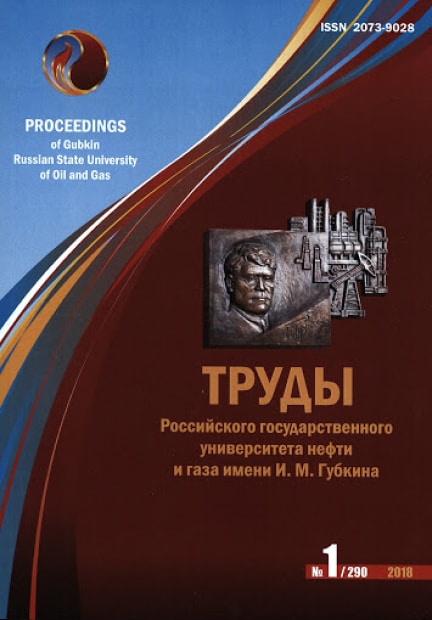ACCOUNT OF OSMOTIC SWELLING CLAYS IN MODELING CLAY RESERVOIRS FOR OIL DEVELOPMENT
UDC: 622.276
DOI: -
Authors:
Kadet Valery V. 1
1,
Chagirov Pavel S. 1
1
1 Gubkin Russian State University of Oil and Gas
Keywords: clay reservoir, flow in porous medium, osmotic swelling, percolation simulation
Annotation:
The analysis of osmotic swelling on the border between the injected agent and clay-containing rock allowed obtaining the dependence of the reservoir properties on the clay content and mineralization rate of injected water. The dependences obtained show that with the decrease in salinity of the injected agent the pore space structure changes, i.e. the share of «fine» pores grows thus by reducing the share of «larg» ones, the variance of the pore radius distribution function as well as porosity decrease. On the basis of micromechanical description of the process of fluid flow in a lattice model of the porous medium analytical dependences of relative permeability curves as a function of salt concentration in the injected fluid were obtained. The process of two-phase flow of Newtonian fluids, one of which is a solution of electrolyte, in clay-containing porous medium was simulated. The influence of the parameters of the porous medium and injected saline fluid on the process of oil displacement was studied.
Bibliography:
1. Tang G.-Q. & Morrow, N.R. Influence of brine composition and fines migration on crude oil/brine/rock interactions and oil recovery. Journal of Petroleum Science and Engineering, 1999, no. 24, p. 99-111.
2. Morrow N., Buckley J. Improved oil recovery by Low-Salinity Waterflooding. SPE 129421.
3. Austad T., Rezaeidoust A. & Puntervold T. Chemical Mechanism of Low Salinity Water Flooding in Sandstone Reservoirs. SPE Improved Oil Recovery Symposium. Tulsa, Oklahoma, 2010. USA: Society of Petroleum Engineers.
4. Ханин А.А. Породы и коллекторы нефти и газа и их изучение. — М.: Недра, 1969. — С. 140-141.
5. Wilcox R., Fisk J. Test show shale behavior, aid well planning. Oil and gas J., 1983, 12/IX, v. 81, no. 37.
6. Румынина В.Г. Оценка влияния атомно-промышленного комплекса на подземные воды и смежные природные объекты. — С-Пб.: Изд-во С.-Петербургского университета, 2003. — С. 85-90.
7. Кадет В.В. Методы теории перколяции в подземной гидромеханике. — М.: центрлитнефтегаз, 2008. — 96 c.
8. Ступоченко В.Е. Влияние глинистости коллектора на полноту вытеснения нефти водой//Геолого-геофизические аспекты обоснования коэффициента нефтеотдачи. — М.: ВНИГНИ, 1981. — Вып. 228. — С. 59-79.
9. Хавкин А.Я., Алишаева О.М. О влиянии минерализации пластовых вод на фазовые проницаемости и выбор оптимальной технологии полимерного воздействия на нефтяной пласт. — М.: вниинефть, 1983. — 11 с.
10. Басниев К.С., Кочина И.Н., Максимов В.М. Подземная гидромеханика. — М.: Недра, 1993. — 408 с.
11. Зарецкий С.А., Сучков В.Н., Животинский П.Б. Электрохимическая технология неорганических веществ и химические источники тока. — М.: Высшая школа, 1980. — 34 с.
12. Селяков В.И., Кадет В.В. Перколяционные модели процессов переноса в микронеоднородных средах. — М.: 1-й ТОПМАШ, 2006. — 247 с.
13. Уляшева Н.М., Ивенина И.В. Влияние ионной силы раствора на скорость увлажнения глинистых пород//Строительство нефтяных и газовых скважин на суше и на море. — 2010. — № 4. — С. 28–30.
14. Макеева Т.Г. Методические новации для уменьшения погрешности определения плотности твердой фазы дисперсных грунтов стандартным методом // Естественные и технические науки. — 2009. — № 5. — С. 231-243.
15. Храмченков М.Г., Эйриш М.В., Корнильцев Ю.А. Изучение структурных изменений и термодинамическая модель фильтрационных свойств глинистых пород//Изв. РАН. Геоэкология. — 1996. — № 5. — С. 65-73.

